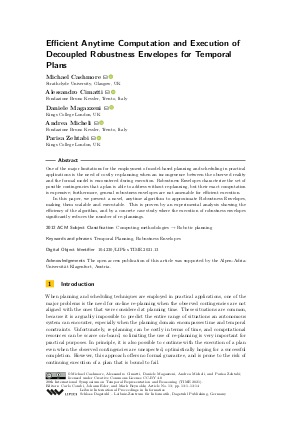Efficient Anytime Computation and Execution of Decoupled Robustness Envelopes for Temporal Plans
Authors
Michael Cashmore  ,
Alessandro Cimatti
,
Alessandro Cimatti  ,
Daniele Magazzeni
,
Daniele Magazzeni  ,
Andrea Micheli
,
Andrea Micheli  ,
Parisa Zehtabi
,
Parisa Zehtabi 
-
Part of:
Volume:
28th International Symposium on Temporal Representation and Reasoning (TIME 2021)
Part of: Series: Leibniz International Proceedings in Informatics (LIPIcs)
Part of: Conference: International Symposium on Temporal Representation and Reasoning (TIME) - License:
 Creative Commons Attribution 4.0 International license
Creative Commons Attribution 4.0 International license
- Publication Date: 2021-09-16
File

PDF
LIPIcs.TIME.2021.13.pdf
- Filesize: 0.86 MB
- 14 pages
Document Identifiers
Subject Classification
ACM Subject Classification
- Computing methodologies → Robotic planning
Keywords
- Temporal Planning
- Robustness Envelopes
Metrics
- Access Statistics
-
Total Accesses (updated on a weekly basis)
0Document
0Metadata
Abstract
One of the major limitations for the employment of model-based planning and scheduling in practical applications is the need of costly re-planning when an incongruence between the observed reality and the formal model is encountered during execution. Robustness Envelopes characterize the set of possible contingencies that a plan is able to address without re-planning, but their exact computation is expensive; furthermore, general robustness envelopes are not amenable for efficient execution. In this paper, we present a novel, anytime algorithm to approximate Robustness Envelopes, making them scalable and executable. This is proven by an experimental analysis showing the efficiency of the algorithm, and by a concrete case study where the execution of robustness envelopes significantly reduces the number of re-plannings.
Cite As Get BibTex
Michael Cashmore, Alessandro Cimatti, Daniele Magazzeni, Andrea Micheli, and Parisa Zehtabi. Efficient Anytime Computation and Execution of Decoupled Robustness Envelopes for Temporal Plans. In 28th International Symposium on Temporal Representation and Reasoning (TIME 2021). Leibniz International Proceedings in Informatics (LIPIcs), Volume 206, pp. 13:1-13:14, Schloss Dagstuhl – Leibniz-Zentrum für Informatik (2021)
https://doi.org/10.4230/LIPIcs.TIME.2021.13
BibTex
@InProceedings{cashmore_et_al:LIPIcs.TIME.2021.13,
author = {Cashmore, Michael and Cimatti, Alessandro and Magazzeni, Daniele and Micheli, Andrea and Zehtabi, Parisa},
title = {{Efficient Anytime Computation and Execution of Decoupled Robustness Envelopes for Temporal Plans}},
booktitle = {28th International Symposium on Temporal Representation and Reasoning (TIME 2021)},
pages = {13:1--13:14},
series = {Leibniz International Proceedings in Informatics (LIPIcs)},
ISBN = {978-3-95977-206-8},
ISSN = {1868-8969},
year = {2021},
volume = {206},
editor = {Combi, Carlo and Eder, Johann and Reynolds, Mark},
publisher = {Schloss Dagstuhl -- Leibniz-Zentrum f{\"u}r Informatik},
address = {Dagstuhl, Germany},
URL = {https://drops.dagstuhl.de/entities/document/10.4230/LIPIcs.TIME.2021.13},
URN = {urn:nbn:de:0030-drops-147895},
doi = {10.4230/LIPIcs.TIME.2021.13},
annote = {Keywords: Temporal Planning, Robustness Envelopes}
}
Author Details
Acknowledgements
The open access publication of this article was supported by the Alpen-Adria-Universität Klagenfurt, Austria.
References
-
C. Barrett, R. Sebastiani, S. Seshia, and C. Tinelli. Satisfiability modulo theories. In Handbook of Satisfiability, pages 825-885. IOS Press, 2009.

-
M. Cashmore, A. Cimatti, D. Magazzeni, A. Micheli, and P.a Zehtabi. Robustness envelopes for temporal plans. In AAAI, 2019.

-
M. Cashmore, M. Fox, D.Long, D. Magazzeni, B. Ridder, A. Carrera, N. Palomeras, N. Hurtós, and M. Carreras. Rosplan: Planning in the robot operating system. In Proceedings of the Twenty-Fifth International Conference on Automated Planning and Scheduling, ICAPS 2015, Jerusalem, Israel, June 7-11, 2015., pages 333-341, 2015.

-
A. Cesta, G. Cortellessa, S. Fratini, A. Oddi, and R. Rasconi. The APSI Framework: a Planning and Scheduling Software Development Environment. In ICAPS (Application Showcase), 2009.

- A. Cimatti, M. Do, A. Micheli, M. Roveri, and D. Smith. Strong temporal planning with uncontrollable durations. Artif. Intell., 256:1-34, 2018. URL: https://doi.org/10.1016/j.artint.2017.11.006.
- R. Dechter, I. Meiri, and J. Pearl. Temporal constraint networks. Artificial Intelligence, 49(1-3):61-95, 1991. URL: https://doi.org/10.1016/0004-3702(91)90006-6.
-
M. Do and S. Kambhampati. Improving temporal flexibility of position constrained metric temporal plans. In ICAPS, pages 42-51, 2003.

- M. Fox and D. Long. PDDL2.1: An Extension to PDDL for Expressing Temporal Planning Domains. Journal of Artificial Intelligence Research, 20:61-124, 2003. URL: https://doi.org/10.1613/jair.1129.
-
J. Frank and A. Jónsson. Constraint-based Attribute and Interval Planning. Constraints, 8(4):339-364, 2003.

-
J. Frank and P. Morris. Bounding the resource availability of activities with linear resource impact. In ICAPS, pages 136-143, 2007.

-
M. Ghallab and H. Laruelle. Representation and control in IxTeT, a temporal planner. In AIPS, pages 61-67, 1994.

-
M. Ghallab, D. Nau, and P. Traverso. Automated planning - theory and practice. Elsevier, 2004.

-
Félix Ingrand and Malik Ghallab. Deliberation for autonomous robots: A survey. Artificial Intelligence, 247:10-44, 2017.

- Mausam and A. Kolobov. Planning with markov decision processes: An ai perspective. Synthesis Lectures on Artificial Intelligence and Machine Learning, 6(1):1-210, 2012. URL: https://doi.org/10.2200/S00426ED1V01Y201206AIM017.
-
N. Muscettola. Computing the envelope for stepwise-constant resource allocations. In CP, pages 139-154, 2002.

-
T. Niemueller, G. Lakemeyer, and A. Ferrein. The robocup logistics league as a benchmark for planning in robotics. Planning and Robotics (PlanRob-15), page 63, 2015.

-
N. Policella, S. Smith, A. Cesta, and A. Oddi. Generating robust schedules through temporal flexibility. In ICAPS, pages 209-218, 2004.

-
A. Schrijver. Theory of Linear and Integer Programming. J. Wiley & Sons, 1998.

-
A. Umbrico, A. Cesta, M. Cialdea Mayer, and A. Orlandini. Integrating resource management and timeline-based planning. In ICAPS, pages 264-272, 2018.

-
B. Williams and V. Gupta. Unifying model-based and reactive programming within a model-based executive. In Workshop on Principles of Diagnosis, 1999.

